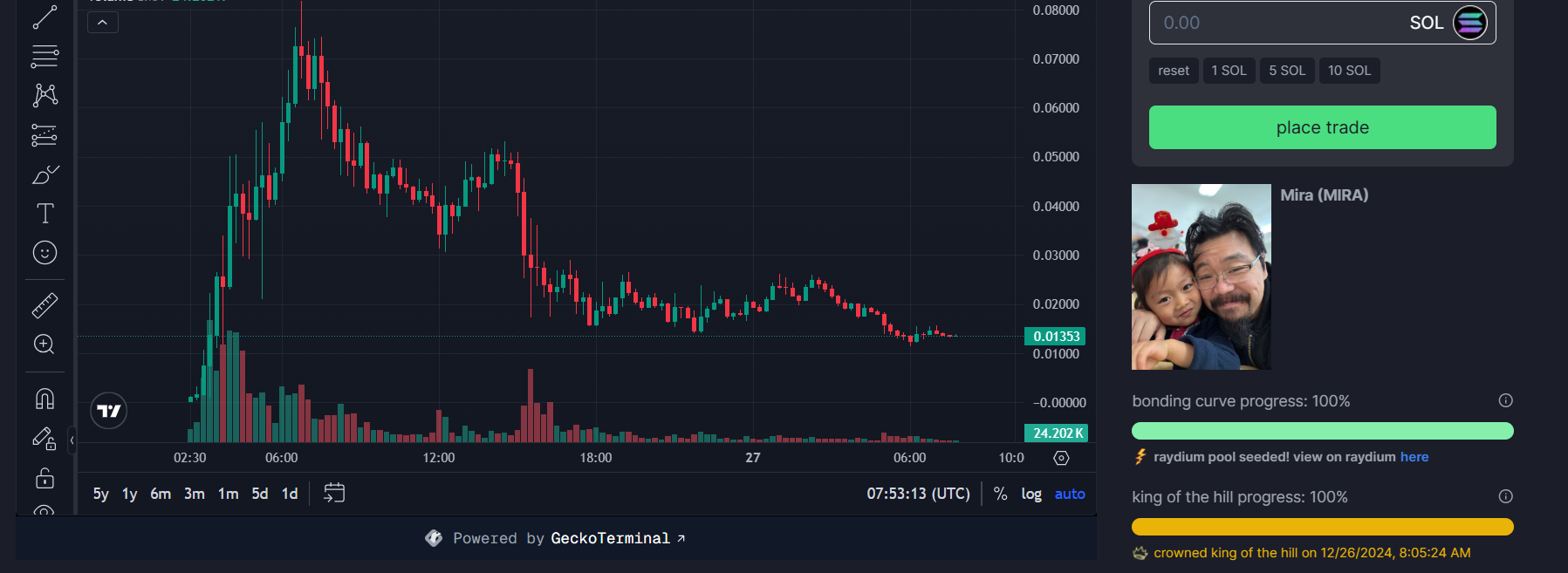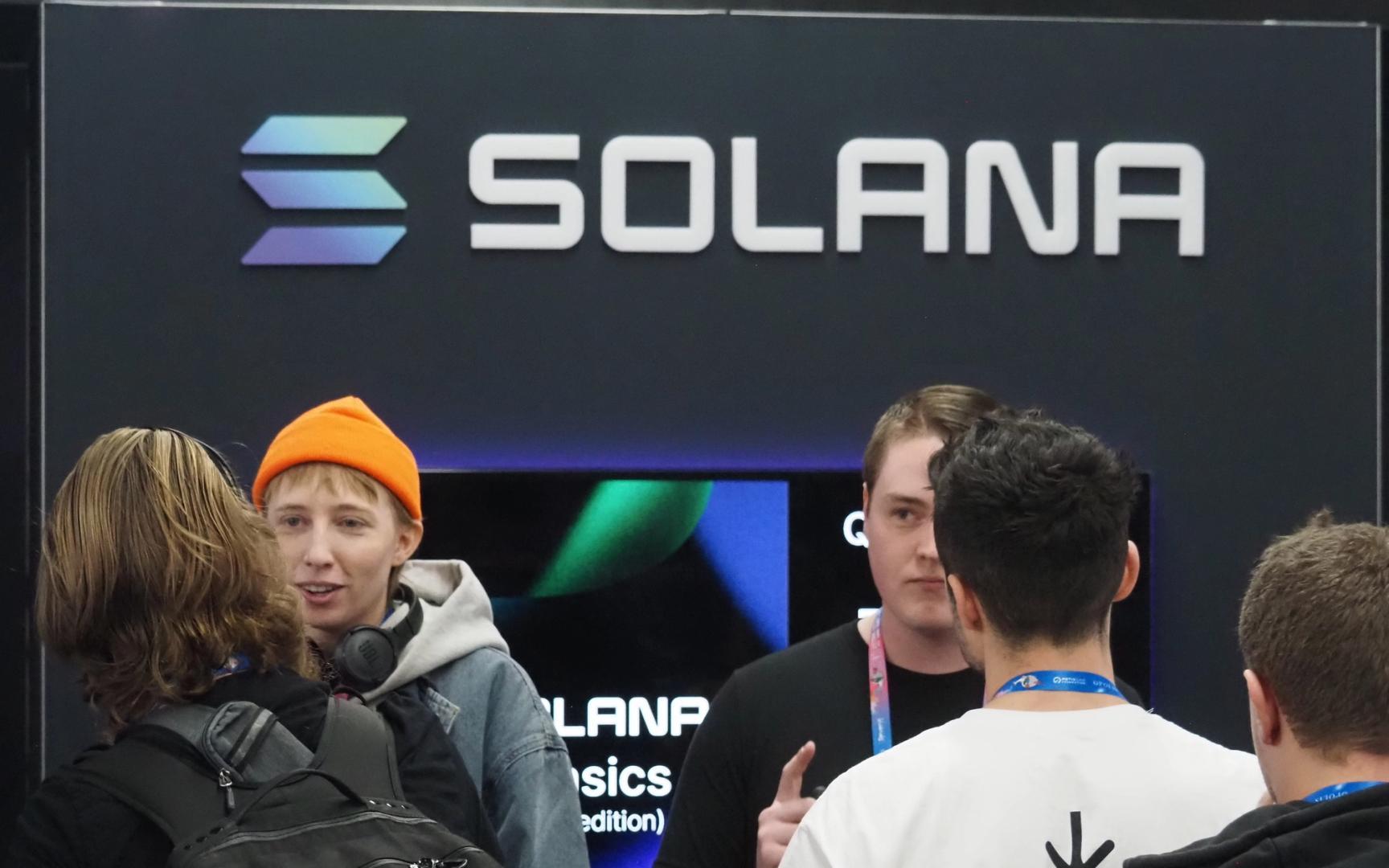Uncategorized
Memecoin Degens Raise Millions for Rare Cancer Research After a Father’s Plea

A Pump.Fun memecoin zoomed from zero to an $80 million market capitalization on Thursday after a father’s plea for donations into a research study for his daughter’s rare brain cancer attracted swathes of crypto traders.
The token’s prices have since fallen 80% since a Thursday peak and trade at just over a cent as of Friday. But while late buyers are sitting on losses, the effort still raised over $1 million for the cause.
In an X post on Thursday, Runaway founder Siqi Chen said his daughter Mira was diagnosed with a type of brain tumor in September and that research and funding had “been lacking” because of how rare the condition was.
His GoFundMe page has raised 80% of its $300,000 target as of Thursday, with all proceeds going directly to research efforts at the Hankinson Lab at the Univerity of Colorado.
Chen also posted his Ethereum wallet on the X thread after user demand, later putting his Solana and Bitcoin addresses as users asked for more options.
And then Pump.Fun happened.
The platform lets anyone issue a token for less than $2 in capital, after which they choose the number of tokens, theme, and meme picture to accompany it. When the market capitalization of any token reaches $69,000, a portion of liquidity is deposited to the Solana-based exchange Raydium and burned.

A user created the MIRA token attached with a picture of Chen and his daughter, with no apparent objective except it being a token that can be traded just like any other memecoin. The user’s Pump.Fun profile shows MIRA was just one of the several tokens they created that day, with all the others failing to break a $6,000 market cap.
X user @Waddles_eth later purchased 50% of the supply and sent all of it to Chen, who boosted the memecoin on his X account.
That ensured virality for the token and sent prices from fractions of a penny to a peak of 8 cents early Thursday. The value of Chen’s token holdings went from $400,000 to over $18 million as the token went viral. It attracted a peak of $7 million in liquidity (worth in both Solana’s SOL and the memecoin) as the market became widely traded.
It attracted over $85 million in trading volumes and over 130,000 transactions, making it the most popular smallcap in the past 24 hours.
“I have been on the internet for 30 years and have seen some shit, but this is by far the craziest day of my life,” Chen wrote on X as prices rocketed. “I will be liquidating $1,000 worth of $MIRA every 10 minutes, perpetually. If change this schedule, i commit to announcing it 24 hours in advance.”
“If you want to rug it to $0, go for it — at the end of the day we set out to raise $200K and we will end up with at least $1M towards rare disease research,” Chen stated.
Community response to the whole event has been overwhelmingly positive, with several users pointing out how such memecoins can contribute to positive outcomes in the world.
Memecoins are largely based on virality, attention and community hype. They are considered non-serious among professional investors but have seen massive demand and preference in the past year compared to larger venture capital-backed crypto tokens — which are perceived as enriching rich investors at the expense of smaller retail traders.
But MIRA shifted some of the tides.
“I think memecoins are dumb and have no future and I don’t touch them. But if I wanted to make a case for them I would now know where to start,” X user @JaEsf said. “This is beautiful and quite crazy that you can do that with crypto. EVM, Solana or any chain. This is why Crypto exist! Simplify movement of assets,” said @mbaril010, another X user.
Meanwhile, @waddles_eth, the user who originally sent half the token’s supply to Chen, said the overall outcome met their expectations.
“When I saw the story about Mira and her illness, I thought it would be good to buy and send supply to you with the hopes of getting the SOL community behind a good cause on Christmas,” they said in a now-viral X post. “I’m really glad that it worked out the way that it has and I hope that the money helps to find a cure both for Mira and anyone else with her condition.”
Crypto for good may finally become a thing in the new year.
Uncategorized
AVAX Surges 10.7% as Bullish Breakout Signals Strong Momentum

Avalanche’s AVAX token has broken out of its multi-week correction phase, demonstrating remarkable strength despite ongoing geopolitical tensions affecting cryptocurrency markets.
The broader market gauge, CoinDesk 20 Index (DLCS), has demonstrated exceptional bullish momentum, surging from 1403.33 to 1461.17 in the last 48 hours, representing a 4.12% gain, while the overall range spans 95.56 points (6.97%) from the low of 1365.61 to the high of 1461.17.
The recent price action of AVAX shows accelerated momentum with the formation of a bull flag pattern and decisive breakout above $20.40, coinciding with significant institutional developments in the ecosystem, according to CoinDesk Research’s technical analysis data.
Technical Analysis Highlights
- AVAX demonstrated remarkable strength, surging from 18.87 to 20.89, representing a 10.7% gain.
- Price action reveals a clear bullish trend with higher lows forming a strong support trendline around 19.50.
- After consolidating between 19.30-19.70 on April 20, AVAX experienced a significant breakout on April 21, with volume increasing substantially as the price pushed above 20.00.
- The most recent 48 hours show accelerated momentum with the formation of a bull flag pattern and a decisive breakout above 20.40, suggesting further upside potential.
- Key resistance at 20.90 now becomes the level to watch, with Fibonacci extension targets pointing to 21.50 as the next significant objective.
- In the last 100 minutes, AVAX surged from 20.61 to 21.04, representing a 2.1% gain.
- After consolidating between 20.50-20.60 during the 13:20-13:40 timeframe, price formed a solid base before initiating a powerful upward move.
- The decisive breakout occurred at 14:40 with extraordinary volume (146,387 units), creating a strong support level at 20.80.
- Multiple high-volume candles followed between 14:44-14:48, pushing the price through the critical 21.00 psychological barrier with the highest volume spike (142,112 units) at 14:47.
- This breakout completes the bullish pattern established in the previous 48 hours, with Fibonacci extension targets now suggesting 21.50 as the next significant objective.
Disclaimer: This article was generated with AI tools and reviewed by our editorial team to ensure accuracy and adherence to our standards. For more information, see CoinDesk’s full AI Policy. This article may include information from external sources, which are listed below when applicable.
External References:
- «Avalanche (AVAX), Toncoin (TON) and Kaspa (KAS): Can They Recover?« — CryptoDaily, published April 2025.
- «Avalanche (AVAX), Polkadot (DOT) Rebound on the Horizon? Harmonic Pattern Signals Bullish Move» — Bitzo, published April 2025. — Bitzo, published April 2025. — Bitzo, published April 2025.
- «Avalanche Price Prediction« — Cryptopolitan, published April 2025.
- «Avalanche Card Unveiled: Will It Spark Bullish Momentum for AVAX?« — Coinpedia, published April 2025.
Uncategorized
Janover Buys Another $11.5M in SOL, Gets Renamed Amid Crypto Treasury Strategy Play

Janover (JNVR), the real estate-focused fintech company with a Solana (SOL) treasury strategy, has been renamed to DeFi Development Corp and purchased another $11.5 million worth of SOL tokens, the firm said on Tuesday.
The move brings the company’s total SOL holdings to 251,842, including staking rewards, the company said. That’s valued at around $36.5 million, with SOL currently trading around $145.
JNVR shares were down 2.5% today at $38.3, well below last week’s peak just shy of $80. However, the stock is still up over 800% since adopting the crypto treasury strategy. SOL advanced nearly 5% over the past 24 hours, with the broader crypto market climbing higher.
The purchase was part of the Boca Raton, Florida-based company’s new crypto bet to position itself as the first U.S.-listed company with a treasury strategy centered on Solana and its native token SOL.
As part of the strategy, the firm seeks to accumulate SOL and operate one or more validators to secure the blockchain. The pivot happened after a team of former executives of crypto exchange Kraken bought a majority stake in the firm earlier this month.
Read more: Janover Takes Page From Saylor Playbook, Doubling SOL Stack to $20M as Stock Soars 1700%
The purchase was made using funds from a $42 million financing round the company completed earlier this year. Based on the latest figures, each share of the company represents 0.17 SOL, up 62% from its last crypto purchase, according to the press release.
The firm will also change its ticker to DFSV on the Nasdaq exchange at a future date to reflect its new name.
Last week, the company announced a strategic partnership with Kraken with plans to delegate part of the exchange’s SOL holdings to stake to validators operated by DeFi Development Corp. The firm also teamed up with BitGo to acquire locked tokens via over-the-counter markets.
Uncategorized
Arch Labs Raises $13M in Funding for Bitcoin-Based Smart Contracts

Bitcoin decentralized finance (DeFi) developer Arch Labs raised $13 million in funding toward building «ArchVM,» which the developers say will provide smart-contract functionality on the original blockchain.
The funding round, which valued the company at $200 million, was led by Pantera Capital, according to an announcement on Tuesday.
Arch’s plans to enable decentralized applications and protocols natively on Bitcoin.
ArchVM will handle off-chain computations to enable «Turing-complete smart contracts at the Bitcoin base layer» and provide Solana-like transaction speeds, Arch Labs said in the announcement.
The goal of introducing smart contracts to Bitcoin began to gather steam in October with the release of the BitVM computing language.
Numerous projects are now using BitVM as the basis for bringing smart contracts to Bitvcoin via layer-2 networks or bridges. Arch’s aim is to avoid the need to bridge assets to layer-2s, which could present additional risks.
-

 Fashion6 месяцев ago
Fashion6 месяцев agoThese \’90s fashion trends are making a comeback in 2017
-

 Entertainment6 месяцев ago
Entertainment6 месяцев agoThe final 6 \’Game of Thrones\’ episodes might feel like a full season
-

 Fashion6 месяцев ago
Fashion6 месяцев agoAccording to Dior Couture, this taboo fashion accessory is back
-

 Entertainment6 месяцев ago
Entertainment6 месяцев agoThe old and New Edition cast comes together to perform
-

 Sports6 месяцев ago
Sports6 месяцев agoPhillies\’ Aaron Altherr makes mind-boggling barehanded play
-

 Business6 месяцев ago
Business6 месяцев agoUber and Lyft are finally available in all of New York State
-

 Entertainment6 месяцев ago
Entertainment6 месяцев agoDisney\’s live-action Aladdin finally finds its stars
-

 Sports6 месяцев ago
Sports6 месяцев agoSteph Curry finally got the contract he deserves from the Warriors





